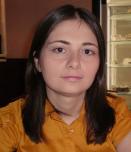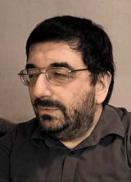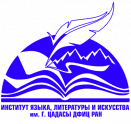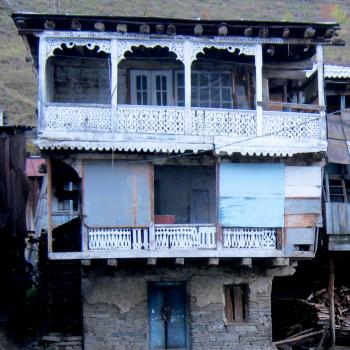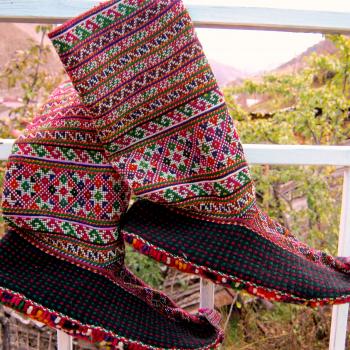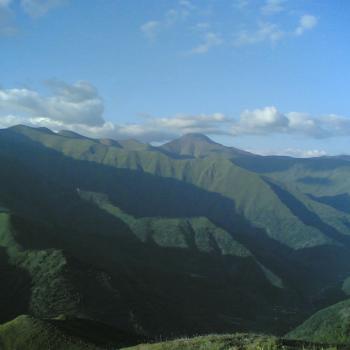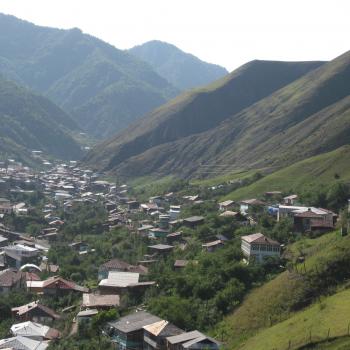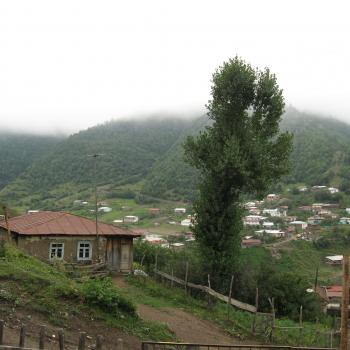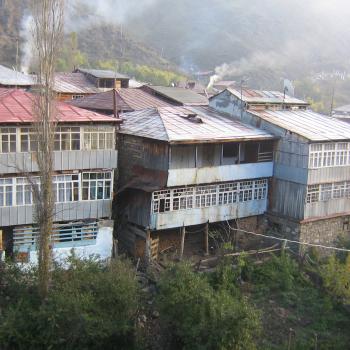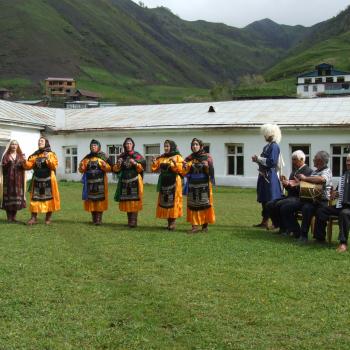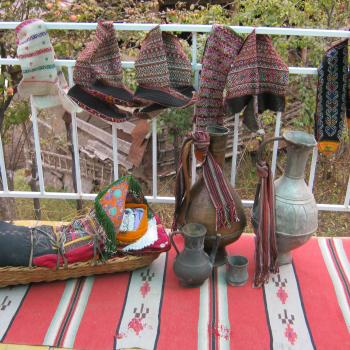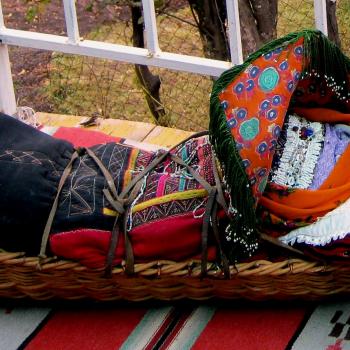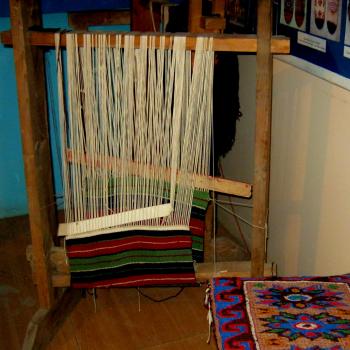Brief Information
Bezhta is spoken on the territory of the Republic of Dagestan, and partially in the Kvareli Municipality of the Republic of Georgia and the Balakan District of the Republic of Azerbaijan. The pattern of settlement is compact in mountainous areas and mixed on the plain. According to the 2010 census, the population of Bezhta people in Russia is 5958 (34 of them live in the urban area, 5924 — in the rural area). According to the individual researchers’ estimates, the total number of Bezhta people in Russia is about 11,000 people; the total number in the world is 12,000. Almost all of the Bezhtas speak Bezhta, except for a small part of the urban youth.
Bezhta is divided into three dialects: Bezhta Proper, Tladal and Khasharkhota.
The main ethnonym in Russian is bezhtincy, in English — the Bezhta. The endonym of the Bezhta is bežƛasa, of the Bezhta language – bežƛalas mic. The etymology of the ethnonym bežƛasa comes from the name of the large main settlement Bezhta (from bežƛa “on the paddock, in the barnyard”. The Georgian name of the Bezhta is Kapuchi (капучинцы in Russian).
The ethnonym qašajqo (Khasharkhota people) comes from the toponym Qašajqoƛa (Khasharkhota); the Khasharkhota dialect is called qašajqolas mic, meaning “Khasharkhota language”.
The ethnonym haƛosa (Tladal people) comes from the toponym Haƛod; the Tladal dialect is called haƛolas mic, which means “Tladal language”.
Bezhta people are engaged in cattle breeding and agriculture. In the past most of the male Bezhta population worked in Georgia and Azerbaijan during the off season.
All Bezhta people are Sunni Muslims.
Genealogy
Bezhta belongs to the Tsezic group of the Nakh-Daghestanian (East Caucasian) language family. Together with Hunzib, it forms the East Tsezic subgroup of the Tsezic languages. Bezhta has three dialects - Bezhta Proper, Tladal and Khasharkhota.
Distribution
Bezhta Proper dialect
Bezhta village of the Bezhta area of the Tsuntinsky District (Dagestan, Russia)
Balakuri village of the Bezhta area of the Tsuntinsky District (Dagestan, Russia)
Isoo village of the Bezhta area of the Tsuntinsky District (Dagestan, Russia)
Zhamod village of the Bezhta area of the Tsuntinsky District (Dagestan, Russia)
Kachalay village of the Babayurtovsky District (Dagestan, Russia)
Vperyod village of the Kizlyarsky District (Dagestan, Russia)
Rybalko village of the Kizlyarsky District (Dagestan, Russia)
Makhachkala city (Dagestan, Russia)
Chantliskuri village of the Kvareli Municipality (Georgia)
Khasharkhota dialect
Khasharkhota village of the Bezhta area of the Tsuntinsky District (Dagestan, Russia)
Kachalay village of the Babayurtovsky District (Dagestan, Russia)
Yuzhnoye village of the Kizlyarsky District (Dagestan, Russia)
Shushanovka village of the Kizilyurtovsky District (Dagestan, Russia)
Stalskoye village of the Kizilyurtovsky District (Dagestan, Russia)
Makhachkala city (Dagestan, Russia)
Shorohi village (previously named Saruso) of the Kvareli Municipality (Georgia)
Tladal dialect
Tladal village of the Bezhta area of the Tsuntinsky District (Dagestan, Russia)
Karaosek village of the Babayurtovsky District (Dagestan, Russia)
Zarechnoye village of the Kizlyarsky District (Dagestan, Russia)
Kraynovka village of the Kizlyarsky District (Dagestan, Russia)
Aleksandro-Nevskoye village of the Tarumovsky District (Dagestan, Russia)
Malaya Areshevka village of the Tarumovsky District (Dagestan, Russia)
Makhachkala city (Dagestan, Russia)
Chantliskuri village of the Kvareli Municipality (Georgia)
Kabahchol village of the Belokan (Balakan) District (Azerbaijan)
Dialects and their distribution
Vitality map
Language contacts and multilingualism
Bezhta people are in contact with Avar, Russian, Hunzib, Hinuq.
Most of the Bezhta people speak Avar, which is the language of inter-ethnic communication among the representatives of the Andic-Tsezic language group. Avar competence amongst the Bezhta people depends on age: the older generation have a good language competence of Avar.
Almost all Bezhta people speak Russian; only children of preschool age are monolinguals. The language of inter-ethnic communication in Dagestan is Russian.
Small part of the Bezhta emigrants from Georgia still speak Georgian; this fact is explained by the historically established trade, economic and political relations with Georgia.
Some of the Bezhta people speak Hunzib and Hinuq at the colloquial level. Bezhta serves as the language of communication with the Hunzib people (partially with the Hinukh people as well).
Language functioning
- Legal status
- Writing system
- Language standardization
- Domains of language usage
Bezhta has no official status. In the Constitution of the Republic of Dagestan, Bezhta is defined as one of the non-written languages of peoples of Dagestan.
Bezhta does not have an officially established writing system. However, the first literary works appeared in the 1990s, which are the Bible translations: the Gospel of Luke (1999), The Book of Proverbs (2005), and four parables from the Gospel of Luke (2018). The Avar alphabet, which is based on Russian graphics, is used in the Bible translations; also considering the phonetic features of Bezhta (the language has about 30 vowels and 32 consonants).
Bezhta has no established literary standard. The native speakers of different dialects speak their own dialects with each other.
Family / everyday communication
Family / everyday communication
Bezhta is used in the family and domestic spheres as well as in the informal communication between the inhabitants of Bezhta villages.
Education
Education
In educational domain, Bezhta is not the subject of study. In rural areas, Bezhta schoolchildren learn Avar as their native language subject. In preschool and primary school, Bezhta is informally the language of instruction and education. There are no textbooks or teaching aids in Bezhta.
Mass media
Mass media
There are no programs in Bezhta on local television. There are no newspapers published in Bezhta.
Culture
Culture
The folklore ensemble «BEZHTA» presents the folk art of the Bezhta people. There are no Bezhta theater and cinema. Avar and Russian are used in these domains.
Science
Science
There are no scientific works published in Bezhta. Russian is used in this domain.
Folklore
Folklore
The following publications of folkloric texts are available:
Khalilov M.Sh. Bezhta-Russian phraseological and folklore-ethnographic dictionary. Leipzig-Makhachkala: Max Planck Institute for Evolutionary Anthropology, 2014.
Khalilov M.Sh. The Language, Folklore and Ethnography of the Bezhta People. Institute for Bible Translation, Moscow, 2017.
Khalilov M.Sh. Na ustax u bezhtintsev: legendy, predaniya, skazki i rasskazy [On the lips of the Bezhtas: legends, lore, tales and stories]. Makhachkala, 2020.
Literature
Literature
There are no literary works created in Bezhta.
However, there are Bezhta translations of the Bible.
Khalilov M.Sh. The Four Parables from the Gospel of Luke in Bezhta. Institute for Bible Translation, Moscow, 2018.
Khalilov M.Sh. The Book of Solomon proverbs in Bezhta. Institute for Bible Translation, Moscow, 2005.
Khalilov M.Sh. Translation of the Gospel of Luke in Bezhta. Institute for Bible Translation, Moscow, 1999.
Religion
Religion
Some of the rituals and chants are performed in Bezhta; additionally, Avar and Arabic are used in religious domain.
Legislation
Legislation
No official documents are published in Bezhta. Russian is used instead.
Administrative activities
Administrative activities
Bezhta is not the language of paperwork management and business correspondence. However, in its oral form Bezhta is often used in the administrations of Bezhta villages.
Legal proceedings
Legal proceedings
Russian is used as the language of legal proceedings in the Republic of Dagestan.
Industry
Industry
There is no industry in the Bezhta region.
Agriculture
Agriculture
Bezhta is used in oral communication.
Trade and service
Trade and service
Bezhta is used in services and trade in the Bezhta villages.
Transport
Transport
Bezhta together with Russian is used in communication in local taxicabs in compact living areas of Bezhta people.
Internet
Internet
There are no official websites, chats and groups in social networks on the Internet in Bezhta. Russian is used in this domain.
Dynamics of language usage
Bezhta remains the primary means of communication among the Bezhta people, despite the fact that most Bezhta identity themselves as Avar. At the same time, the knowledge of Avar among the Bezhta people is decreasing every year due to the spread of mass media (television, radio, press, etc.) in Russian. Nowadays, the knowledge of Russian is almost absolute.
The knowledge of Bezhta is considerably high in compact living areas. In general, the transmission of Bezhta to the children is maintained. The level of proficiency of Bezhta amongst the youngest generation living in urban areas is decreasing.
Language structure
Phonetics
Bezhta has 30 vowel and 32 consonant phonemes
Phonetics
Vocalism. Bezhta has the following vowels: short vowels (a, i, e, o, u), long vowels (a:, i:, e:, o:, u:), umlauted vowels (ä, ö, ü), nasalized vowels (aⁿ, iⁿ, eⁿ, oⁿ, uⁿ), nasalized umlauted vowels (äⁿ, öⁿ, üⁿ), long umlauted vowels (ä:, ö:, ü:), long nasalized vowels (a:ⁿ, i:ⁿ, e:ⁿ, o:ⁿ, u:ⁿ).
Consonantism. There are no pharyngealized and labialized consonants. The most common oppositions for Bezhta consonants are voiced and voiceless, ejective and non-ejective consonants. The plosives have the following triads (voiced, voiceless, ejective): b — p — p’, d — t — t’, g — k — k’. The affricates have the opposition of ejective and non-ejective consonants: c — c’, č — č’, ƛ — ƛ’, q — q’. The fricatives have the voiced and voiceless opposition: z — s, ž — š, ʁ — χ, ʔ — h. The unpaired fricatives: w, ɬ, j. The sonorants — m, n, r, l.
There is a harmony in a number of sibilants in frames of one lexeme (s/š, z/ž, c/č, c’/č’), thus the affixes alternate according to the phonetic structure of the word stem (see Kibrik А. Е., Kodzasov S. V. A comparative study of the Dagestan languages. The Verb. Мoscow, MSU, 1988). A syllable with an unumlauted vowel cannot follow a syllable with an umlauted vowel. For example, äʁä-lä-ƛ’ä ‘ear-OBL-SUP’, j-üⁿq’-čä ‘IV-eat-PRS’.
The most typical syllable structures are CV, CVC, VC. They appear in anlaut, inlaut and auslaut.
Morphology
Morphological type of the language: agglutinative with fusional and analytic elements.
Morphology
Bezhta is classified as an agglutinative language (with rich nominal and verbal morphology), with some fusional elements in word formation and analytic elements in structure of some verb forms. The following parts of speech are represented in Bezhta: noun, adjective, numeral, pronoun, verb, adverb, postpositions, particles, interjections.
Syntax
Bezhta is classified as the language with ergative–absolutive alignment. The basic word order is SOV, but in general the word order is free.
Syntax
Bezhta like other languages of the family is mainly verb-final, though with no rigid order of the major clause constituents. The syntactic/semantic role of noun phrases in the clause is indicated primarily by means of case marking. It is a dependent-marking ergative language.
Complex sentences are formed with the help of various non-finite forms: masdar, participle, infinitive, and converbs. The participle is used as the head of a relative clause. Numerous converbs form converbal clauses. Infinitives, verbal nouns and participles are used in constructions with sentential arguments.
Vocabulary
The Avar, Arabic, Georgian, Persian, Russian and Turkic languages are the main sources of word borrowing.
Vocabulary
There are two major lexicon stratum, inherent and borrowed. The inherent vocabulary forms the major body of the lexicon. Chronologically, the earlier borrowings are from Avar, Arabic, and Georgian, and the later ones are from Persian, Turkic, and Russian. The biggest number of borrowings comes from Arabic, Georgian and Russian, the lowest number — from Avar, Farsi and Turkic. The majority of borrowed words are indirect borrowings, which came via Avar and Georgian.
Language experts
Madzhid Sh. Khalilov
(Makhachkala, Russia)The author of many works on phonetics, morphology, word formation, and lexicology of Bezhta. He is the author of the Bible translations into Bezhta, the author of the first Dictionary of the Bezhta language, of the chrestomathy of Bezhta texts and the co-author of the Bezhta grammar.
Bernard Comrie
(Santa Barbara, USA (California))The author of multiple works on morphology and syntax of the Tsezic languages including Bezhta.
Zaira M. Khalilova
(Moscow, Russia)She works on documentation of Bezhta.
Yakov G. Testelets
(Moscow, Russia)Yakov Testelets is one of the authors of the grammatical description of the Bezhta language (Tlyadal dialect).
Research centres
Institute of Language, Literature and Art named after Gamzat Tsadasa, Dagestan Scientific Center of RAS (Makhachkala, Dagestan, Russia)
One of the main research theme of the institute is documentation of non-written minority languages of Dagestan. Within this research framework, M.Sh. Khalilov, a specialist in in the Tsezic languages, prepared “The Bezhta-Russian Dictionary” (1995),
“Bezhta-Russian Phraseological and Folklore-Ethnographical Dictionary” (2014), and “The Language, Folklore and Ethnography of the Bezhta People” (2017).
Institute of Linguistics of the Russian Academy of Sciences
The researchers of the Institute of Linguistics Y.G. Testelets (Department of Caucasian Languages) and Z.M. Khalilova (Laboratory for the study and preservation of small languages) are working on documentation of Bezhta.
Max-Planck-Institut für evolutionäre Anthropologie (Max Planck Institute for Evolutionary Anthropology)
Max Planck Institute for Evolutionary Anthropology (Germany) and partially Leiden University (Netherlands) have supported the publication of several works on Bezhta, which are “The Bezhta-Russian Dictionary” (1995), “Bezhta-Russian Phraseological and Folklore-Ethnographical Dictionary” (2014), and “The Language, Folklore and Ethnography of the Bezhta People” (2017) were published.
Core references
Grammatical descriptions: grammars, sketches
Bernard Comrie, Madzhid Khalilov, and Zaira Khalilova. 2015. Grammatika bezhtinskogo yazyka (Fonetika. Morfologiya. Slovoobrazovanie) [A grammar of Bezhta]. Leipzig-Makhachkala: Max Planck Institute for Evolutionary Anthropology.
Madieva, G.I. Grammaticheskiy ocherk bezhtinskogo yazyka [Grammatical description of the Bezhta language]. Makhachkala, the publication of Dagestan State University, 1965.
Dictionaries
M.Sh. Khalilov. Bezhtinsko-russkiy slovar' [The Bezhta-Russian Dictionary]. Makhachkala, 1995.
M.Sh. Khalilov. Slovar' bezhtinskogo yazyka [The Dictionary of the Bezhta language]. Makhachkala: Alef, 2015.
Selected papers on grammatical issues
Bokarev E.A. Bezhtinskiy yazyk [The Bezhta language.] // Tsezskie (didoyskie) yazyki Dagestana. Moscow, AN URSS, 1959. p. 66–109.
Comrie B. Verb stems and verb inflection in Bezhta // Philologie, Typologie und Sprachstructur- Philology, Typology and Language Structure: Festschrift für Winfried Boeder zum 65. Geburtstag / Festschrift for Winfried Boeder on the Occasion of his 65th Birthday / Ed. by Wolfram Bublitz, Manfred von Roncador, and Heinz Vater. Frankfurt am Main: Peter Lang, 2002. Р. 251–264.
Comrie B., Khalilov M. Loanwords in Bezhta, a Nakh-Daghestanian of the North Caucasus // Loanwords in the World’s languages. A comparative handbook. Berlin, 2009.
Comrie B., Khalilov M., Khalilova Z. Valency and valency classes in Bezhta // Valency classes / Ed. by Wolfram Bublitz, Manfred von Roncador, and Heinz Vater, eds.: Berlin: de Gruyter Mouton, 2015. Р. 541–570.
Comrie B., Forker D., Khalilova Z. General noun modifying clause constructions in Hinuq and Bezhta, with a note on other Daghestanian languages // General noun modifying clause constructions / Ed. by Yoshiko Matsumoto, Bernard Comrie & Peter Sells. Amsterdam: Benjamins, 2017. P.121–146.
Khalilov M., Khalilova Z. Word formation in Bezhta // Word-Formation: An International Handbook of the Languages of Europe / Ed. by Müller, Peter O., Ingeborg Ohnheiser, Susan Olsen & Franz Rainer. Berlin/New York: Mouton de Gruyter (= Handbooks of Linguistics and Communication Science, HSK 40), 2016. P. 3597–3616.
Kibrik A. E., Testelets Ja. G. Bezhta // The Indigenous Languages of the Caucasus, 3: The North East Caucasian Languages Part 1 / Ed. by Job, Michael. Delmar, NY: Caravan Books, 2004. P. 217–295.
Publications of texts
Khalilov M.Sh. Translation of the Gospel of Luke in the Bezhta language. Institute for Bible Translation, Moscow, 1999.
Khalilov M.Sh. The Four Parables from the Gospel of Luke in the Bezhta language. Institute for Bible Translation, Moscow, 2018.
Khalilov M.Sh. The Book of Solomon Proverbs in the Bezhta language.] Institute for Bible Translation, Moscow, 2005.
Khalilov M.Sh. Na ustakh u bezhtintsev: legendy, predaniya, skazki i rasskazy. [On the lips of the Bezhtas: legends, lore, tales and stories.] Makhachkala, 2020.
Resources
Corpora and text collections
There is no publicly available electronic corpus of Bezhta. There is a collection of texts in Bezhta with 60,000 tokens.
Other electronic resources
The Intercontinental Dictionary Series (IDS), which is a database with lexical material, contains wordlists of Bezhta in three dialects:
Bezhta Proper — 1731 entries, Khasharkhota — 1896 entries, Tladal — 2315 entries.
Database of Bezhta verbal valency
Bible translations into Bezhta are available not only in printed versions, but also in electronic formats, which are an e-book, an application with texts for a mobile device, audio versions of the Bible translation into Bezhta, Bible translations for smartphones, and the program “Electronnaya Biblia [“Electronic Bible”] for Windows, Linux, Mac.
The Bezhta-Russian voiced dictionary contains 25 word entries. The dictionary is constantly updated.
Data for this page kindly provided by
Zaira Madzhidovna Khalilova (Institute of Linguistics of the Russian Academy of Sciences, Moscow).





